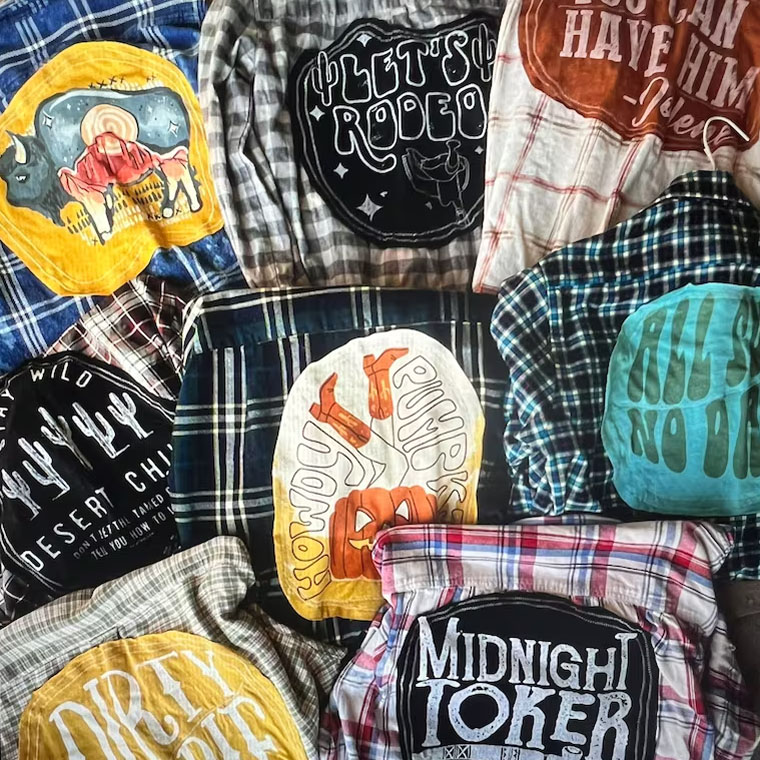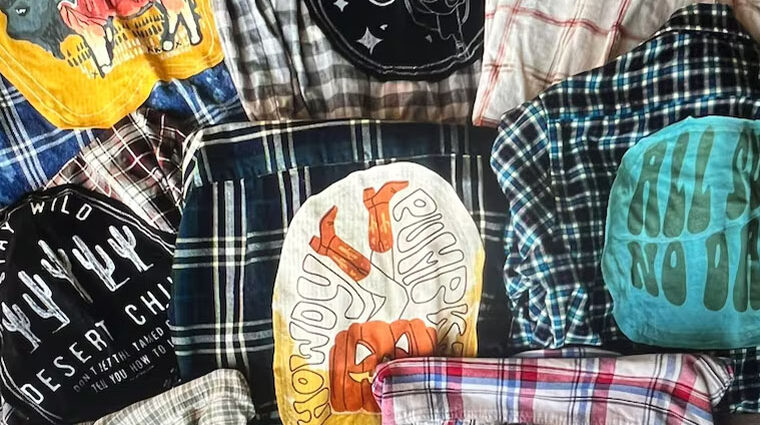What is Patches ?
There are several types of patches; here are the most common and widely known: Mending, Decorative, Identification, Heat Transfer, Reflective, Iron-On, Name or Monogram, Embroidered, Quilt, and Removable patches.
Patches can be crafted from a diverse array of materials, tailored to their intended use and design. Common choices include fabric, embroidery, leather, metal, and denim. Within this context, we are specifically exploring the unique characteristics of flannel patches.

What is Flannel Patches ?
A Flannel Patch is simply a patch made from Flannel Fabric, which is a soft and cozy material often created from wool, cotton, or a mix of Fibers. These patches are known for being warm and comfortable, and they’re used to add a snug and rustic feel to clothes or textiles. So, in simple terms, a Flannel Patch is a soft and comfy addition to make things look and feel cozy!
How Flannel Patches Made
The process of making Flannel Patches involves several steps. Here’s a simplified overview:
- Material Selection: Choose a suitable flannel fabric based on color, pattern, and texture preferences.
- Pattern Design: Create or choose a design for the patch. This may include shapes, logos, or decorative elements.
- Cutting: Cut the flannel fabric according to the chosen design, leaving some extra fabric around the edges for sewing.
- Sewing or Adhering: If the patch is small and straightforward, it may be sewn onto the garment or item directly. For larger or more intricate designs, the patch can be sewn onto a base fabric or adhered using an appropriate adhesive.
- Finishing Touches: Trim any excess fabric, and ensure that the patch is securely attached. If desired, additional elements like embroidery or decorative stitching can be added.
- Quality Check: Inspect the patch to ensure it meets quality standards. Check for any loose threads, uneven stitching, or other imperfections.
- Optional Treatments: Depending on the desired look, the flannel patch can undergo additional treatments, such as distressing for a vintage appearance or washing to enhance softness.
- Final Inspection: Conduct a final check to ensure that the Flannel Patch is ready for use, whether as a decorative embellishment or a functional addition to clothing or textiles.
Purpose of Flannel Patches
Flannel patches serve various purposes, combining both functionality and aesthetics. Here are a few key purposes:
- Decorative Embellishment: Flannel patches are often used as decorative elements on clothing, bags, or other textiles. They add a touch of coziness and a rustic aesthetic, enhancing the visual appeal of the item.
- Personalization: People use flannel patches to personalize their belongings. Whether it’s adding patches to jackets, backpacks, or even home decor items, it allows individuals to express their unique style and preferences.
- DIY Fashion: Flannel patches are popular in do-it-yourself (DIY) fashion projects. Crafters and individuals with a creative flair can use these patches to transform plain garments into personalized and stylish pieces.
- Repair and Reinforcement: In addition to their decorative role, flannel patches can be employed for practical purposes. They are often used to mend or reinforce areas of clothing that have experienced wear and tear, extending the life of the garment.
- Seasonal and Theme-Based Design: The warmth and comfort associated with flannel make it a popular choice for patches during colder seasons. Seasonal or theme-based designs, such as those with holiday motifs, contribute to a festive and inviting atmosphere.
- Crafting and DIY Projects: Flannel patches are commonly used in crafting and DIY projects. Whether making quilts, pillow covers, or custom accessories, flannel patches add a tactile and cozy dimension to handmade creations.
- Symbolic or Sentimental Value: Patches can carry symbolic or sentimental value. They might represent a particular interest, hobby, or hold emotional significance, making them a meaningful addition to personal items.
- Educational or Organizational Identification: In educational institutions or organizations, flannel patches can signify membership or achievements. They are often used as identifiers on uniforms or team apparel, fostering a sense of belonging and pride.
In conclusion, flannel patches are versatile additions to textiles, serving a dual purpose of functionality and aesthetics. These patches, crafted from soft and cozy flannel fabric, find applications in both decorative and practical realms. Whether adorning clothing for a personalized and rustic appeal, mending and reinforcing worn areas, or contributing to DIY and crafting projects, flannel patches offer a tactile and visually pleasing dimension. Their seasonal adaptability, sentimentality, and organizational identification further contribute to the diverse roles they play in enhancing textiles, making them a popular choice for those seeking warmth, style, and personal expression in their belongings.

